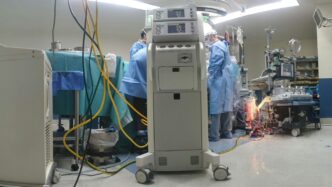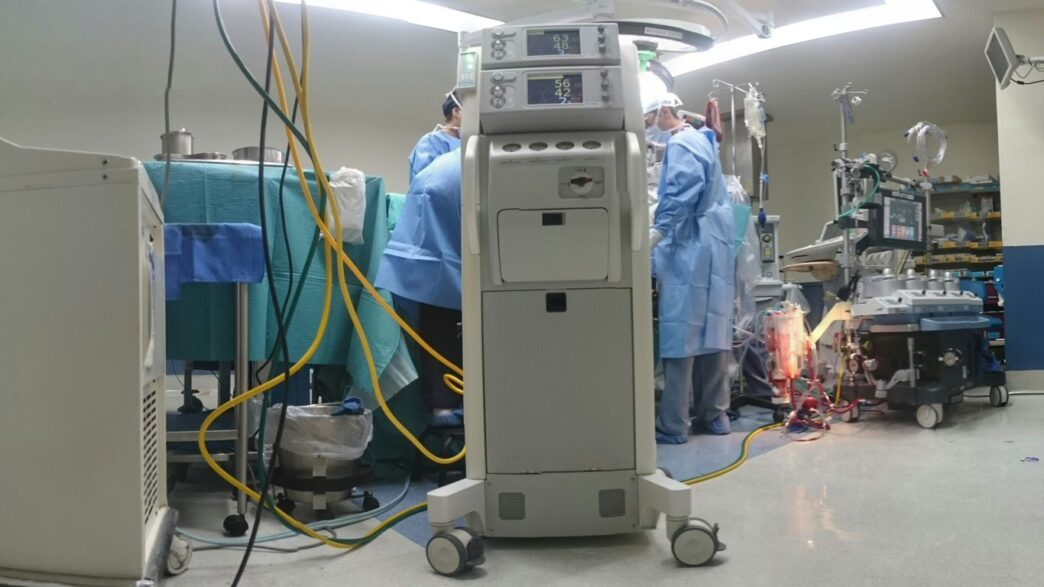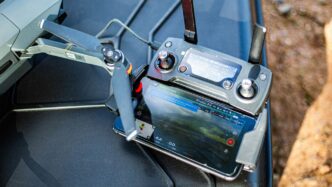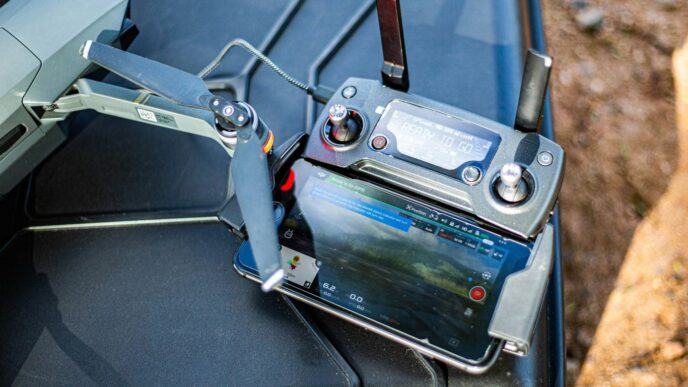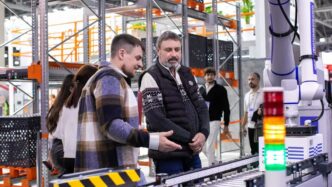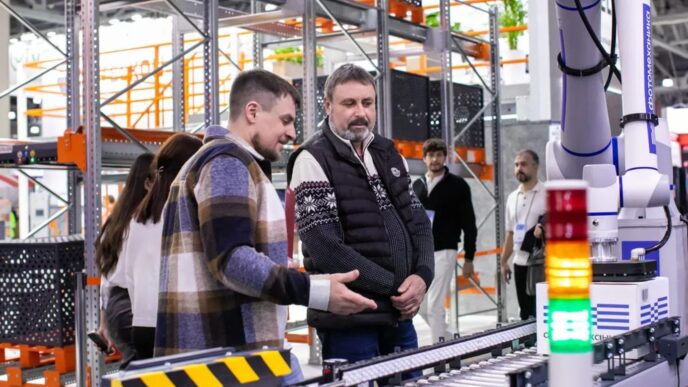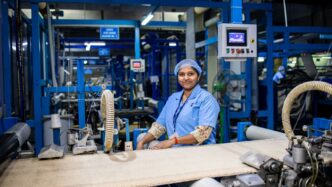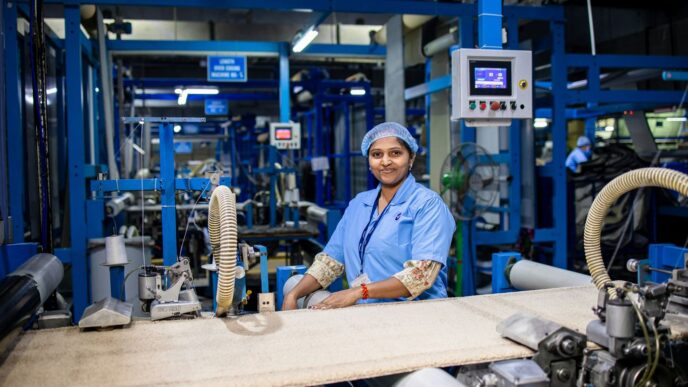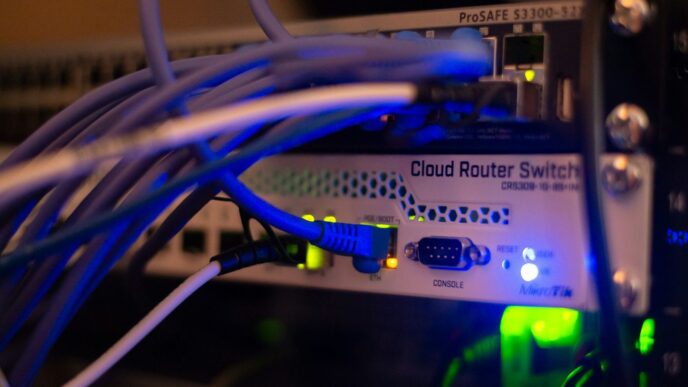Getting a good look inside the lungs for diagnosis has always been tricky. Traditional methods could only go so far, leaving doctors guessing about what was happening deep inside. But now, things are changing. Johnson & Johnson’s jnj monarch platform is shaking things up, bringing a new level of precision to bronchoscopy. It’s like giving doctors robotic superpowers to see and reach places they couldn’t before, all while keeping things as simple and safe as possible for the patient.
Key Takeaways
- The jnj monarch platform is a robotic system designed to improve bronchoscopy procedures.
- It helps doctors get to hard-to-reach spots in the lungs for better diagnosis.
- Newer versions, like Monarch Quest, use AI and better imaging for more accurate navigation.
- This technology aims to help find lung cancer earlier, potentially improving patient outcomes.
- The jnj monarch system is part of a growing market for robotic tools in medicine.
The JNJ Monarch Platform: A New Era in Bronchoscopy
It feels like just yesterday we were talking about the big leaps in medical tech, and now, Johnson & Johnson is really shaking things up with their Monarch platform for bronchoscopy. This isn’t just a small upgrade; it’s a whole new way of looking at how we diagnose and treat lung issues, especially when it comes to lung cancer. The Monarch system is designed to give doctors a much better shot at reaching those tricky spots deep inside the lungs.
Revolutionizing Lung Cancer Diagnosis
Lung cancer is a tough one, and a big part of the problem is catching it early. A lot of the time, suspicious spots, or nodules, are way out in the edges of the lungs, making them hard to get to with older methods. Traditional bronchoscopy can struggle to reach these peripheral areas, which is where nearly half of early-stage lung cancers hide. The Monarch platform changes that game. By using robotic precision, it can navigate these smaller airways more effectively. This means doctors can potentially get a sample, or biopsy, of these nodules sooner and with less trouble.
Minimally Invasive Access to Peripheral Lesions
Think about it: getting to those tiny nodules often meant more serious procedures with higher risks. The Monarch system aims to sidestep that. Its design allows it to go deeper into the lung’s airways than before. This is a big deal because it can mean avoiding things like needle biopsies that go through the chest wall, which can sometimes lead to collapsed lungs or other complications. It’s all about making the diagnostic process less of a burden on the patient.
Enhancing Diagnostic Precision with Robotic Assistance
So, how does it actually work? The robotic assistance is key. It gives the doctor more control and a steadier hand, especially when working in those delicate lung passages. This precision is what helps in getting a good sample from the right spot. It’s like having a super-steady, highly skilled extension of the doctor’s own hands, allowing them to see and reach places that were previously out of bounds or very difficult to get to.
Technological Advancements Driving JNJ Monarch
Leveraging NVIDIA’s Computational Power
The Monarch system’s capabilities have seen a big jump thanks to some serious computing muscle. Johnson & Johnson partnered with NVIDIA, and this collaboration has really paid off. The Monarch platform now uses NVIDIA’s accelerated computing setup, which is a fancy way of saying it has way more processing power. We’re talking about a 260% increase in real-time processing. This extra power lets the system run complex artificial intelligence algorithms right then and there, during the procedure. This means the robot can think and react faster, making it much better at guiding the scope through the intricate pathways of the lungs. It’s like giving the system a super-smart brain that helps it navigate with more confidence and accuracy.
Integration with GE Healthcare Imaging
Getting a clear picture during a bronchoscopy is super important, and that’s where GE Healthcare comes in. The Monarch platform now works with GE’s OEC 3D mobile imaging system. This integration means doctors get a more complete view of what’s going on inside the patient’s lungs during the procedure. It’s not just about seeing; it’s about seeing in 3D and with more detail. This combined approach helps pinpoint suspicious areas more precisely, which is a big deal when you’re trying to find tiny nodules that could be early signs of cancer.
AI-Powered Navigation for Enhanced Accuracy
Artificial intelligence is really changing the game here. The Monarch system uses AI not just for processing power but specifically to help with navigation. Think of it like a super-advanced GPS for the lungs. The AI algorithms analyze the patient’s anatomy and the real-time data from the scope to plot the best course. This is especially helpful when trying to reach those hard-to-get-to spots deep in the lungs. The system’s ability to use AI for navigation means it can potentially reduce the time it takes to perform a biopsy and, more importantly, increase the chances of getting a good sample from the right spot the first time. This accuracy is key to getting patients diagnosed and treated faster.
Clinical Impact of the JNJ Monarch System
Earlier Detection of Suspicious Lung Nodules
Finding lung nodules early is a big deal, especially when it comes to lung cancer. The Monarch system really helps doctors get a closer look at those suspicious spots, even the ones tucked away in the outer parts of the lungs. These areas are notoriously tricky to reach with older methods. This improved access means we can potentially catch problems sooner than before. Getting a diagnosis faster can make a huge difference in how well a patient does.
Reducing the Need for Invasive Procedures
Before robotic systems like Monarch, if a nodule was hard to reach, doctors might have had to resort to more involved procedures. Think things like needle biopsies that go through the chest wall or even surgery just to get a sample. These methods come with their own set of risks, like a collapsed lung. The Monarch platform’s ability to navigate deep into the lungs with its flexible scope means it can often get the biopsy sample needed without putting patients through those more invasive steps. It’s all about making things safer and less stressful for the patient.
Improving Lung Cancer Survival Rates
When you put it all together – earlier detection and less invasive biopsies – the ultimate goal is to help people live longer. Lung cancer is tough, but catching it in its earliest stages dramatically improves survival odds. The Monarch system, by making it easier and more reliable to get those early diagnoses, plays a part in that bigger picture. It’s about giving patients a better chance by getting them on the right treatment path sooner. It’s pretty amazing how technology can directly impact patient outcomes like this.
JNJ Monarch Quest: The Latest Innovation
Johnson & Johnson’s Monarch platform just got a significant upgrade with the introduction of Monarch Quest. This isn’t just a minor tweak; it’s a substantial step forward in how we approach lung biopsies. The big news is the integration of advanced AI algorithms and improved imaging, aiming to make reaching those tricky spots in the lungs much more precise.
So, what’s new under the hood? Well, they’ve really ramped up the processing power. By using NVIDIA’s computational platform, the system’s real-time processing speed has jumped by a whopping 260%. This extra oomph allows for more complex AI programs to run during a procedure. Think of it like upgrading your computer from the dial-up era to fiber optic internet – everything just happens faster and smoother.
Here’s a quick rundown of what Monarch Quest brings to the table:
- AI-Powered Navigation: The system now uses artificial intelligence to help guide the robotic catheter through the patient’s airways. This should help doctors get to suspicious nodules more accurately.
- Verified OEC Interface: It integrates with GE Healthcare’s OEC 3D mobile imaging system. This means doctors get better, more detailed 3D views of the lungs right there during the procedure, which is pretty handy for planning and execution.
- Expanded Digital Capabilities: The whole process, from planning before the procedure to analyzing data afterward, is now more connected. This digital approach aims to streamline the entire workflow for the medical team.
This update is all about making it easier and more reliable to biopsy those small, hard-to-reach lung nodules. The goal is to catch lung cancer earlier, when treatment options are often more effective. It’s pretty neat how technology is making these complex procedures more manageable and potentially improving patient outcomes.
The Growing Market for Robotic Bronchoscopy
Johnson & Johnson’s Strategic Investment
It’s pretty clear that Johnson & Johnson sees big things ahead for robotic bronchoscopy. They made a huge move back in 2019, buying Auris Health for a cool $3.4 billion. That was all about getting their hands on the Monarch technology. This wasn’t just a small purchase; it showed they’re serious about making a name for themselves in the robotic surgery world. And they’re not stopping there. They’ve even got plans for a new soft tissue surgical robot called Ottava, which is supposed to go head-to-head with some of the big players already out there. It feels like they’re really putting their money where their mouth is, aiming to be a major force in this evolving field.
Competition in the Robotic Bronchoscopy Space
While J&J is making waves with Monarch, they’re not the only ones in this game. Intuitive Surgical has their Ion system, and it’s a pretty direct competitor. Think of it like two companies trying to build the best remote-controlled car – both have their own approach and features. The market is still pretty new, especially here in the US, but it’s growing fast. It’s exciting to see these companies pushing each other to innovate. This competition is good for doctors and patients because it means better tools are likely to come out sooner.
The Future of Minimally Invasive Pulmonary Procedures
So, what does all this mean for the future? Robotic bronchoscopy, like the Monarch system, is changing how doctors can look inside the lungs. It’s opening up new possibilities for finding lung issues earlier and with less risk to the patient.
Here’s a quick look at what we can expect:
- Better Access: These robots can get to those hard-to-reach spots in the lungs that were really difficult with older methods. This means more accurate diagnoses.
- Less Invasive: The goal is to avoid more serious procedures. If a robot can get a good sample from a suspicious spot, it might mean a patient doesn’t need something riskier like surgery.
- Smarter Tools: We’re seeing more advanced tech being added, like better imaging and AI. This helps doctors pinpoint problems more precisely and plan treatments more effectively.
It really feels like we’re just at the beginning of what these robotic systems can do for lung health.
Understanding the JNJ Monarch Technology
So, how does this Monarch system actually work? It’s pretty neat, honestly. It uses a combination of technologies to help doctors get a better look inside the lungs.
Electromagnetic Navigation and Real-Time Vision
One of the key things is how it guides the scope. It uses something called electromagnetic navigation. Think of it like a super-precise GPS for the inside of the body. This system tracks the tip of the bronchoscope in real-time, showing exactly where it is on a 3D map of the patient’s lungs. This means the doctor can see where they’re going, even in those twisty, hard-to-reach airways. It’s not just about knowing the location, though. The system also provides real-time visual feedback, so the doctor has a constant view of the path ahead. This combination of precise tracking and live video is what makes it possible to reach those tiny spots deep in the lungs.
Scope-in-Sheath Design for Stability
Another clever bit of engineering is the "scope-in-sheath" design. Basically, the flexible bronchoscope sits inside a protective outer tube, or sheath. This setup does a couple of things. For starters, it makes the whole thing more stable when it’s inside the lung. This stability is important for accurate maneuvering, especially when you’re trying to biopsy something small. It also helps protect the delicate scope itself. It’s like having a sturdy, yet flexible, guide that keeps everything steady.
Continuous Peripheral Vision for Safety
Safety is obviously a big deal when you’re working inside someone’s lungs. The Monarch system is designed with continuous peripheral vision. This means that even as the scope is moving deeper into the airways, the doctor maintains a wide field of view. They can see not just the immediate path but also the surrounding lung tissue. This helps avoid accidental bumps or damage to other parts of the lung. It’s like having eyes all around the tip of the scope, making the whole procedure safer for the patient.
Looking Ahead
So, the Monarch platform from Johnson & Johnson is really changing the game for lung procedures. It’s all about getting to those hard-to-reach spots in the lungs more easily and accurately, which means doctors can find problems like cancer earlier. With the new software upgrades, especially the AI stuff and better imaging, it’s becoming even more precise. This is a big deal because finding lung cancer early makes a huge difference for patients. It seems like this kind of robotic help is going to become more common, making things safer and potentially faster for everyone involved.

